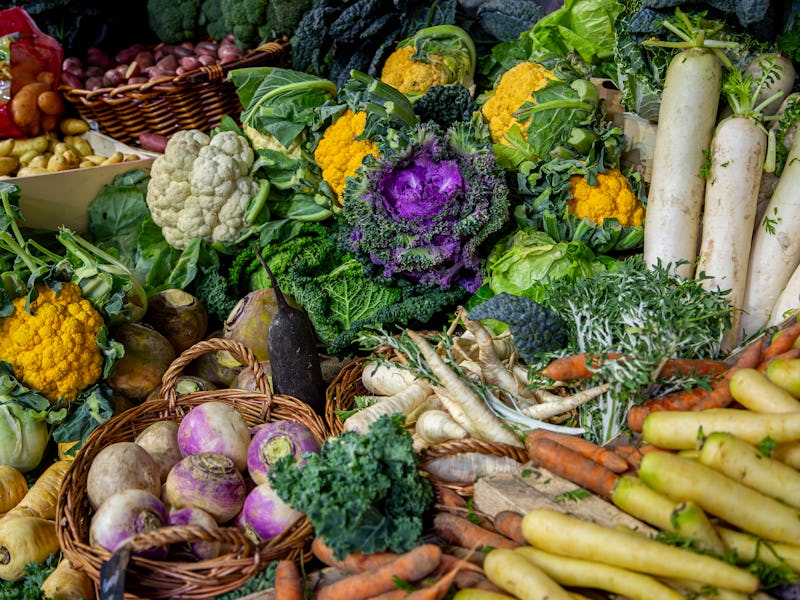This Ancient Diet Goes Against Everything We Know About Early Humans
Thousands of years before agriculture, one group of people was eating a lot of plants.

The Flintstones may be a cultural touchstone, but it probably comes as no surprise that the show tells us little about what Stone Age life was actually like — especially when it comes to eating. Contrary to what the cartoon depicts, pre-agricultural hunter-gatherers were not chowing down on brontoburgers. Still, even modern researchers’ ideas of what so-called cavemen ate is murky.
Experts are still trying to understand what early humans consumed in the millennia before farming. A dearth of well-preserved human remains leave a gap in our knowledge of how fledgling Homo sapiens ate. One group of ancient humans known as Iberomaurusians, who lived about 15,000 to 13,000 years ago, left clues in the form of teeth and bone remnants. A team of researchers in France, Germany, the U.K., and Morocco performed a new type of analysis on remnants from the Iberomaurusians to deduce what they ate pre-agriculture. Their recently published paper in the journal Nature Ecology & Evolution describes a surprising discovery about how one group of people in modern-day Morocco ate.
The team examined 25 teeth and 7 bone samples from a total of 17 individuals from a burial site called Taforalt in North Africa. The group used a technique called isotope analysis on dental enamel, bone collagen, and amino acids, and found that these Iberomaurusians were eating a plant-rich diet several thousand years before the advent of agriculture.
“In Europe, what we see usually is that hunter-gatherers were eating a lot of meat or fish,” says Klervia Jaouen, the paper’s senior author and a geochemistry researcher at the National Centre for Scientific Research’s laboratory Géosciences Environnement Toulouse in France. “And this is not what we see here.” The fact that Jaouen’s team looked at a group of people in North Africa rather than Morocco already starts to broaden possibilities and challenges assumptions.
Instead, Jaouen and her cohort saw isotopic evidence that reflects a plant-heavy diet. Based on the plants available to the region as well as the photosynthetic pathways identified in the analysis, it’s likely the Iberomaurusians subsisted in part on wild pulses, acorns, and pine nuts. In fact, Jaouen says these Iberomaurusians’ diet was as predominantly herbivorous as that of an agricultural society. However, they weren’t totally herbivorous; they also hunted Barbary sheep and gazelles.
The Iberomaurusians aren’t the first group of early humans to demonstrate a plant-rich diet in the age before agriculture. Another group of hunter-gatherers, called the Natufians, in western Asia exploited wild plant growth to the degree that they eventually cultivated and domesticated them, leading to formal agriculture. It’s surprising that the Iberomaurusians, who were contemporaries of the Natufians, were eating so many plants because agriculture arrived in North Africa between 8,000 and 3,000 years after it did for the Natufians.
Isotope analysis is a common archaeological practice to determine ancient eating patterns by identifying different isotopes, which are atoms of a particular element with a different number of neutrons than normal. Part of why this method is effective is because “we are made of elements that come from our foods,” Klervia says.
Typically, isotope analysis looks for carbon, nitrogen, oxygen, and strontium isotopes. However, this study is the first to use zinc isotopes, which allowed the researchers to track a broader diet over a longer period of time than the traditional isotopes allow. Jaouen wants to apply this technique to the study of human remnants that came from Europe to see whether their diet was really as meat-heavy as we thought.
“There's more diversity than what we believed,” she says.
Going forward, Jaouen and her team are trying to document the transition from Paleolithic to Neolithic eras in North Africa in general. Ultimately, they want to compare the dietary habits from these two time periods, which will let us better understand how different human populations outside of Europe adapted.
“We built the story from data that were restricted to a small geographical area,” says Jaouen. “And it's interesting to expand this and to see that everything was a bit more complex.”